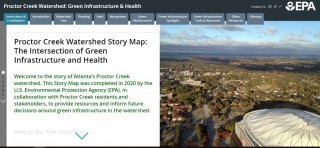
Health Impact Assessment (HIA) is a decision-support tool being utilized by EPA to promote sustainable and healthy communities. The foundation of a healthy community is strongest when built upon a decision-making process that balances environmental, social, and economic factors to promote the health and well-being of its members. HIA is a tool designed to investigate how a proposed program, project, policy, or plan may impact health and well-being and inform decision-makers of these potential outcomes before the decision is made.
HIAs consider the full range of potential impacts of the proposed decision — both positive and negative — on health and those factors known to directly and indirectly affect human health (known as health determinants). HIAs provide recommendations for maximizing the potential positive health impacts and minimizing and/or avoiding the potential negative health impacts of the decision. In addition to promoting human health considerations, HIAs also encourage democracy, health equity, a comprehensive approach to individual and community health, and sustainability in decision-making.

In 2013, the Proctor Creek watershed (Atlanta, GA) was designated an Urban Waters Federal Partnership location. Grassroots organizations, EPA, the Urban Waters Federal Partnership, City of Atlanta, and others work together to improve and protect the health of Proctor Creek and address the environmental and health-related issues facing the community. In collaboration with the Proctor Creek community, EPA conducted a health impact project to evaluate the expansion of green infrastructure throughout the watershed – a recommendation of the Boone Boulevard Green Street Project Health Impact Assessment (HIA) previously conducted by EPA.
While not an HIA, this community-driven project utilized a similar process and is communicated as an interactive Story Map – an easy-to-use online tool that combines maps with narrative text, images, and multimedia content – to tell the story of Atlanta’s Proctor Creek watershed and the role that green infrastructure can play in the community.
A Story Map is an easy-to-use online tool that combines maps with narrative text, images, and multimedia content to convey information as a story and inform and connect with viewers.
The Story Map explores community-identified concerns, such as flooding and water quality, urban heat islands, mosquitoes, and health, and considers the potential for green infrastructure to address those concerns. The Story Map examines the proposed expansion of green infrastructure throughout the Proctor Creek watershed, evaluates the potential impacts of this expansion on environmental and public health, and highlights areas in the Proctor Creek community that may benefit from green infrastructure practices. In addition to examining the intersection of green infrastructure and health, the Story Map also provides resources about demographics and health in Proctor Creek and addresses additional concerns raised by the community, including illegal dumping of trash and tires, toxic releases to land, and brownfields.
Related Resources
The Health Impact Assessment (HIA) Resource and Tool Compilation is a free, publicly-accessible compilation of tools and resources being developed by EPA that can be utilized by HIA practitioners at all levels of experience to guide them through the HIA process.
The HIA resources and tools contained in the Compilation were identified through:
The HIA Resource and Tool Compilation is designed to provide an extensive list of resources that apply to the HIA process itself and the themes present throughout the process, such as equity and community participation, as well as tools that can be used to collect and analyze data, establish a baseline profile, assess potential health impacts, and establish benchmarks and indicators for recommendations and monitoring. The Compilation is divided into several primary categories based on the resource or tool type (e.g., HIA Process Resources, Databases, Guidance Documents, Analysis Tools, Models, Mapping Tools, and Data Collection Tools). The resources and tools are further categorized by the topic (or in some cases, the HIA step) to which that resource or tool pertains (e.g., Monitoring and Evaluation, Demographics, Housing, Transportation, etc.).
EPA performed a review of 81 Health Impact Assessments (HIAs) from the U.S. to obtain a clear picture of how HIAs are being implemented nationally and to identify potential areas for improving the HIA community of practice. The review was focused on HIAs from four sectors that the EPA’s Sustainable and Healthy Communities Research Program has identified as target areas for empowering communities to move toward more sustainable states. These four sectors are:
The Minimum Elements and Practice Standards for Health Impact Assessment was chosen from the broad body of HIA guidance documents as the benchmark against which to review the HIAs. The HIA Review systematically documented organizations involved in conducting the HIAs; funding sources; the types of community-level decisions being made; data, tools, and models used; self-identified data needs/gaps; methods of stakeholder engagement; pathways and endpoints; characterization and prioritization of impacts; decision-making outcomes/recommendations; monitoring and follow-up measures; HIA defensibility and effectiveness; attainment of the Minimum Elements of HIA; areas for improvement; and identification of best practices.
The results of the HIA review were synthesized to identify the current state of the HIA practice in the U.S., best practices in HIA, and areas for improvement.
Related Resources
EPA has undertaken several case studies to learn how Agency science can be used in the HIA process, and how completed HIAs can be incorporated into Agency decision-support tools, actions, and missions.